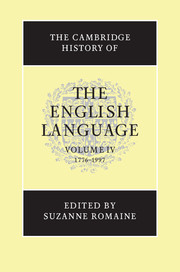5 - PHONOLOGY
Published online by Cambridge University Press: 28 March 2008
Summary
The soundscapes of the eighteenth and nineteenth centuries
Superficially, the period under consideration might appear to contain little of phonetic and phonological interest, compared with, for example, earlier changes such as the transition from Old to Middle English, and the Great Vowel Shift (see CHEL III, forthcoming). Thus, Millward claims that ‘by 1800, the [consonant] system was identical to that of today’ (Millward 1989: 215), and that ‘the PDE vowel inventory was achieved by the end of the EMnE period, although there have been some allophonic and distributional changes since 1800’ (Millward 1989: 219). Jespersen draws attention to a limited number of changes: for example, /n/ being used sometimes for /ŋ/ in unstressed position (singin’, bringin’, etc.), the use of intrusive /r/ from the end of the eighteenth century, the growing instability of the phonemic contrast between /ʍ/ and /w/ (e.g. where and wear), variability in the use of word-initial /h/ (e.g. in humour, hospital, humble), the loss of /j/ (e.g. in tune), and, for some speakers, the substitution of /w/ for /v/ in words like very and sorry (Jespersen 1909: 355 et seq). Similarly, Wyld notes comparable examples which show that a number of relatively small changes (systemic, structural, lexical-incidental, and realisational) had been in progress between about the middle of the eighteenth century and the First World War (Wyld 1914: 133–60. See also Horn & Lehnert 1954: passim).
- Type
- Chapter
- Information
- The Cambridge History of the English Language , pp. 373 - 535Publisher: Cambridge University PressPrint publication year: 1999
References
- 8
- Cited by



